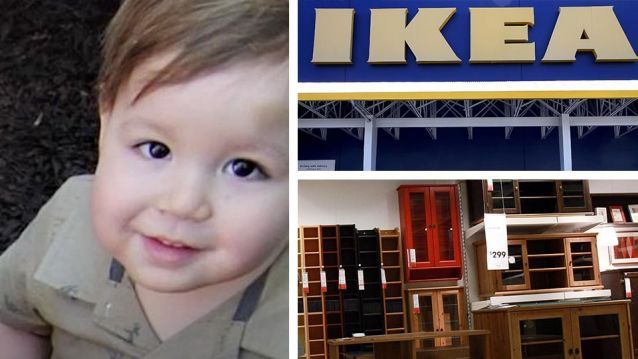Did you know that, on average, one child dies every two weeks when a television or a piece of furniture like a dresser falls onto him or her? Sadly, another toddler has reportedly been crushed to death by an unsecured IKEA dresser. Last year, the furniture giant recalled millions of chests and dressers over the risk of deadly tip-over accidents. But, unfortunately, the toddler’s parents weren’t aware that their Malm dresser had been recalled.
Lawyer claims IKEA recall was poorly advertised
Shortly after he was put down for a nap, 2-year-old Jozef Dudek died when he was crushed by an IKEA Malm dresser, according to a statement from a representative for the family. This accident marks the eighth known fatality tied to an unsecured IKEA dresser, and the first since last year’s recall. The recall, which began last June, offered IKEA customers full or partial refunds as well as providing free wall-anchoring kits to make the furniture safe to use. The recalls involved not just dressers from Ikea’s Malm line, but also dozens of other models sold by the retailer over decades.
Last year, IKEA also paid $50 million in a settlement to three families who lost children in tip-over accidents, reports The Washington Post. The children, no more than 2-years old, died when IKEA dressers toppled over them. In each case, the furniture was one of IKEA’s Malm dressers. Malm dressers represented more than one-fourth of the 29 million dressers recalled. But Jozef’s parents weren’t aware that their Malm dresser had been recalled, said Daniel Mann, who is representing the family, to NPR. Mann believes “Jozef’s tragic death was completely avoidable.” He claims that “last year’s so-called recall was poorly publicized by IKEA.”
In a statement, a spokeswoman for IKEA said the dresser had not been attached to the wall and encouraged consumers to use anchors included with its products. “Our hearts go out to the affected family, and we offer our sincere condolences during this most difficult time,” said Mona Astra Liss, a spokesman for IKEA. The company has also redesigned many of its dressers to meet the industry’s safety standard, which requires dressers to remain upright without being anchored when a 50-pound weight is hung on a drawer.
Preventing tip-over incidents is easy and inexpensive
Tens of thousands of times a year, falling furniture and TVs injure or kill people, says the Philadelphia Enquirer, who has extensively investigated tip-over deaths. But experts say it doesn’t have to be that way. In fact, about four times per hour, tip-overs send someone in the U.S. to an emergency room.
Alarmingly, more than half are children, many under five years old. Occasionally, these accidents are loud, with shattering glass and splintering wood, but often they are quiet because the child’s body muffles the impact, reports the Philadelphia Enquirer. What makes it more unbearable is the guilt parents feel, which is why many deaths don’t lead to lawsuits. But some parents say their regrets aren’t from having ignored a warning. Many had never heard of tip-overs until one killed their child.
According to Anchor It, an estimated 33,000 consumers are injured each year due to tip-over incidents. Ninety-one percent of tip-over fatalities occur in the home and 46 percent of tip-over fatalities occur in a bedroom. On average, one child dies every two weeks when a TV or a piece of furniture falls onto him or her.
How to secure your furniture
Secure your TVs and furniture by following some simple steps, and you could protect your child from injury:
- A television should only be placed on furniture designed specifically to hold a television, such as a television stand or media center. Even if a TV is not wall mounted, it should still be anchored to the wall. It’s just good practice to mount a flat-screen TV to the wall or even to the surface of a TV stand to prevent it from toppling over.
- Existing furniture can also be anchored with inexpensive anti-tip brackets. New furniture, such as dressers, are sold with anti-tip devices. Install them right away to avoid any accidents.
- Also, remove items, such as toys and remote controls, from the tops of dressers, bookcases and TVs that might tempt children to climb.
Anti-tip devices are sold online and in-stores for $5 to $25. But you can also visit your local home improvement center, electronic or mass merchandise store to purchase anti-tip devices. You can also go online and search for “anti-tip strap” or “anti-tip kit” for a variety of options.
Make sure to install the anti-tip devices according to manufacturer instructions. And, always double check the attachment points to make sure the device is secure. A few preventative measures could stop a child or adult from seriously becoming injured — and a lifetime of grief.
— Katherine Marko

